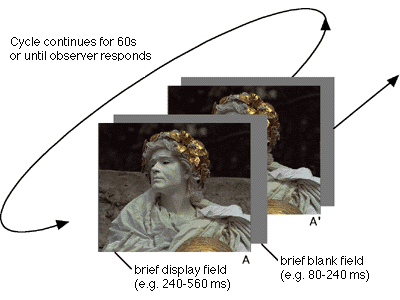
PIs: Ron Rensink, J. Kevin O'Regan, Jim Clark
Project Team: Vlada Aginsky, Monica Strauss, Janis Breeze
Reference: Rensink RA, O'Regan JK, and Clark JJ (1997). To See or Not to See: The Need for Attention to Perceive Changes in Scenes. Psychological Science, 8:368-373.
The goal of this project is to determine why drivers can "look but fail to see". A large fraction of traffic accidents are of this type: drivers collide with pedestrians in plain view, with cars directly in front of them (the classic "rear-ender"), and even run into trains. (That's right -- run into trains, not the other way around.) In such cases, information from the world is entering the driver's eyes. But at some point along the way this information is lost, causing the driver to lose connection with reality. They are looking but they are not seeing.
What's going on? Our findings indicate that the critical factor is attention: To see an object change, it is necessary to attend to it.
To show this, we developed a "flicker" paradigm in which an original and a modified image continually alternate, one after the other, with a brief blank field between the two (see Figure 1 below). The onset of each blank field swamps the local motion signals caused by a change, short-circuiting the automatic system that normally draws attention to its location. Without automatic control, attention is controlled entirely by slower, higher-level mechanisms which search the scene, object by object, until attention lands upon the object that is changing. Thus, these conditions generate a form of invisibility: it can become very difficult to see a change that is obvious once attended.
To see this effect for yourself, try out the following:
